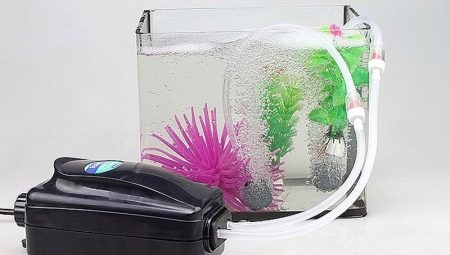It is extremely difficult to imagine the beauty of the aquarium world without bubbles that randomly rise to the surface from a decorative structure in the form of a slide or fortress. And the bubble effect is created thanks to the aerator or, as it is easier called aquarists, to the compressor.
The operation of this unit is in the injection of oxygen and its dissolution in the water. In aquariums where there are no living plants or grow in insufficient quantities, the compressor is an indispensable device. Only equipping water with oxygen is not the only function of the aerator. Versatile possibilities are inherent in this unit.

What is it needed for?
In the wild, algae are responsible for the process of equipping water with oxygen. But unfortunately, this exchange is very slow. The aquarium environment works in a similar way. Without additional equipment, oxygen molecules do not have time to sink to the bottom of the aquarium, and in some cases, the process of natural metabolism can take about a month.
In densely populated aquariums, the number of growing algae should not have certain boundaries. At the same time, it may seem to many that from an aesthetic point of view, due to the diversity of plants, living creatures simply do not have enough space. Only in fact, everything looks different. In the daytime, algae enrich the water with oxygen, and with the onset of night, the process of photosynthesis stops. Plants, along with fish and other aquarium inhabitants, are turning into consumers. Just in such cases, aerators come to the rescue.
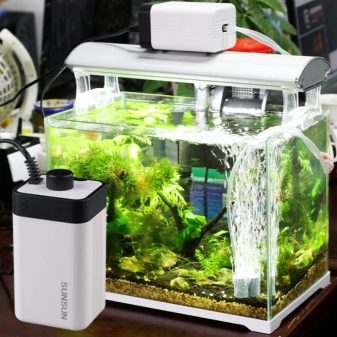
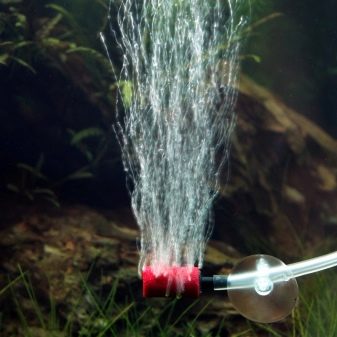
Thanks to effective aeration, metabolic processes are stabilized in the aquarium inhabitants and the healthy vital activity of their organisms is maintained. The occurrence of a lack of oxygen in water is very simple to determine. First of all, fish begin to suffer. Their mobility is lost, they become lethargic, pale, painful specks appear on the scales. With oxygen deficiency, living things constantly stay almost on the surface, in some cases they refuse to eat.
Plants also suffer from a lack of oxygen. But most importantly, due to the lack of the required amount of oxygen, water suffers. It begins to turn sour, becomes cloudy and develops a pathogenic environment within itself that negatively affects the living organisms living in it.
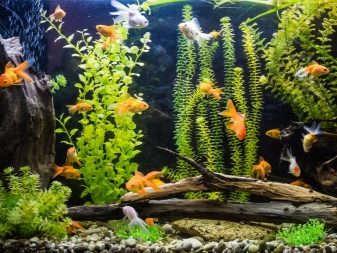
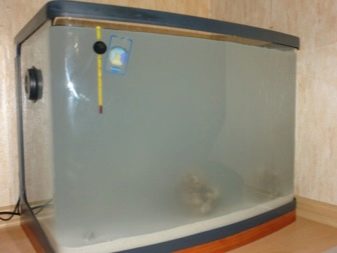
To find out the exact amount of oxygen present in the water, special tests, sold in whole sets, will help. Although some aquarists have more confidence in hydrogen peroxide experiments.
In addition to its main purpose, the aerator in the aquarium environment improves the circulation of water, thereby helping the filter, thereby increasing the efficiency of the compressor. When working together, these two irreplaceable aquarium elements prevent the occurrence of bacterial accumulations on the surface. In addition, a kind of water elevator formed by the compressor mixes the water, which eliminates the likelihood of stagnation.
Among other things, aerator helps to equalize the temperature of the liquid in the aquarium over the entire area, thus protects the fish from sudden changes in heat and cold. It’s important for aquarists to remember - the smaller the compressor releases the bubbles, the faster the process of oxygen exchange in water.

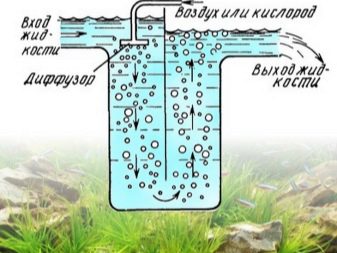
To date, compressors of various shapes and sizes are used both for industrial purposes and at home, but there are some exceptions. For example, aerator installation is not required in aquariums where males or gourami live. These fish are inherent in water bodies, deprived of oxygen. For this reason, they independently collect air from the surface of the water. But other species of fish do not share this uniqueness, and we are talking not only about living things, but also about most plants.
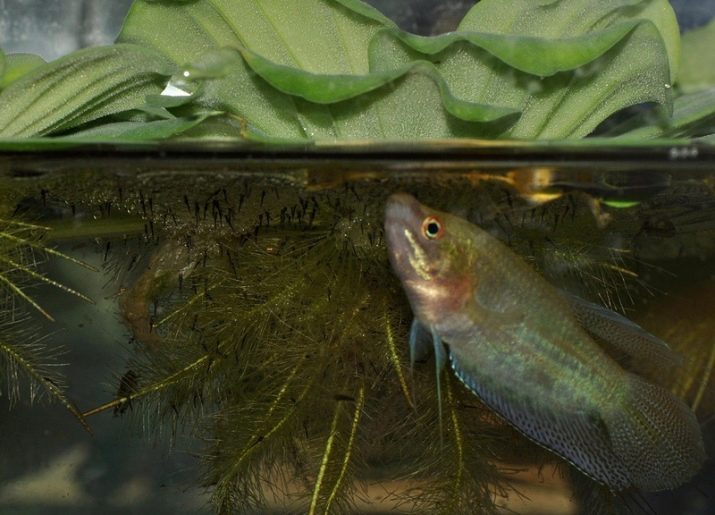
Without an aerator, they dry very quickly and even die, since the lack of oxygen upsets the biological balance.
Kinds
Today, there is a huge variety of compressors designed for placement in aquariums. At the same time, only some options are used for home glass containers, but each of them has its positive and negative sides.

Initially, you need to familiarize yourself with the features of the main types of aquarium aerators.
- Membrane constructions. The main difference between this type of aerators is a special rubberized membrane that pumps the air layer unilaterally. An important advantage of membrane models is minimal energy consumption, and modern manufacturers in the manufacture of such equipment create almost silent devices. Unfortunately, these practical modifications have some drawbacks. To begin with, a low power level should be noted. Almost all membrane aerators are designed for aquariums with a volume of not more than 150 liters.
If the fluid volume exceeds the specified indicator, you will have to purchase 2 or even 3 compressors, setting their work at full capacity.
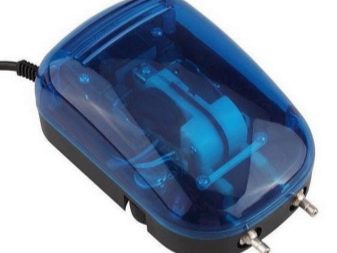
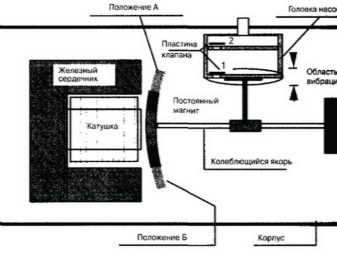
- Piston designs. In the recent past, aerators equipped with a piston reproduced a loud buzzing sound and vibration, and current models practically do not make noise. In addition, they are distinguished by good power. The principle of operation of the piston system of aerators is quite simple. The piston moves, air is forced into the water.In addition, each individual modification differs in the length of the rod and the amplitude of the piston stroke.
Due to the high power, which was mentioned earlier, the air is able to rise to any height. And the simplicity of the system of products of the represented type of aerators is capable of serving faithfully for more than one year.
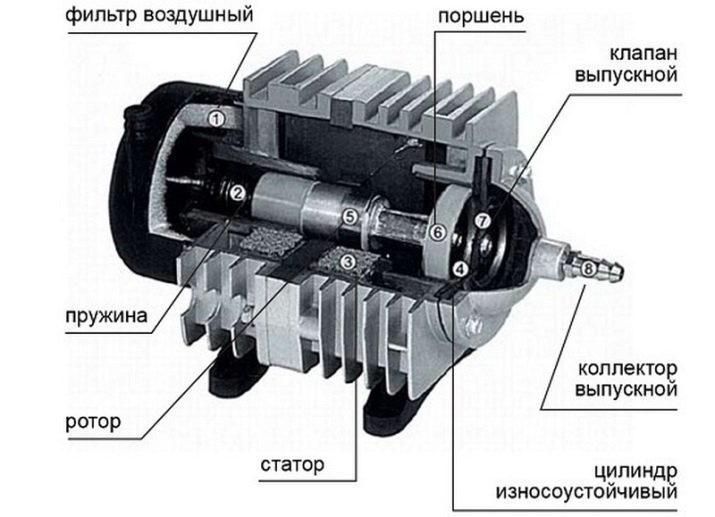
Further, it is proposed to familiarize yourself with the varieties of the presented types of aerators, each of which meets the requirements of any aquarist, has the ability to adjust the air supply or has a cleaning filter.
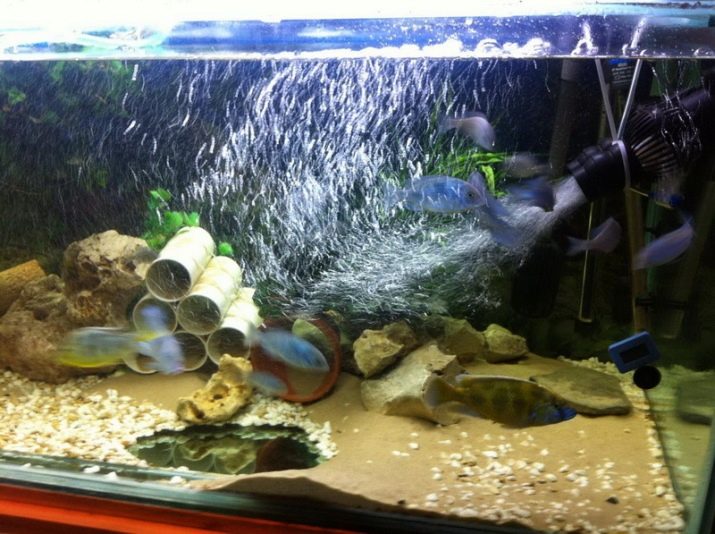
Silent
Having installed the presented type of aerators in your aquarium, you can stop worrying about sleepless nights. Wherein The quietest mode of operation is different kind of air electric compressor. Quite often, aquarists solve the issue of silent operation of the unit, closing the device in the cabinet. But this requires a large length of the air tube, which will have to be additionally purchased and installed.
In order not to carry out a lot of manipulations, it’s best to get a silent aerator model right away. In addition, modern quiet compressors do not create additional vibration during operation.
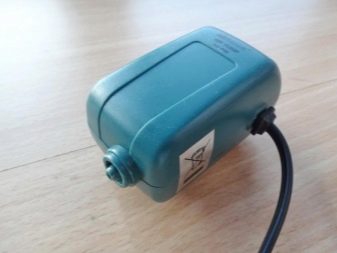
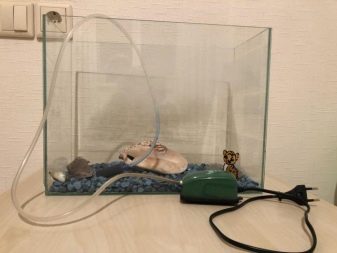
Special attention should be paid piezo compressors. A fairly modern submersible modification that does not emit any noise during operation. Their miniature forms are neatly mounted on the glass or hidden at the bottom, so they are not visible to the naked eye at all. A piezo compressor of this type is used in aquariums with a volume of about 80 liters.
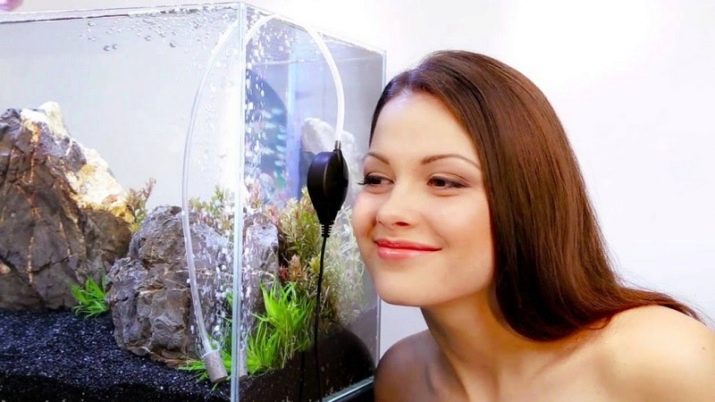
Air
The essence of his work is to compress the trapped air, which is then fed into the liquid of the tank. Along with the air version, there are oxygen and nitrogen units, but for home-type aquariums, it’s best to buy an air aerator.
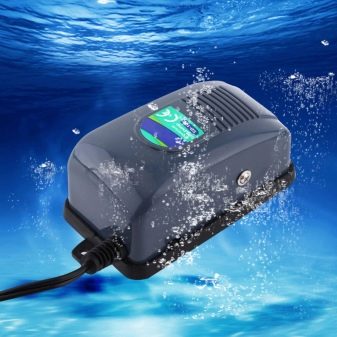

Battery operated
A very useful option for compressors for aquariums that do not have a permanent power source nearby. Unfortunately, such varieties have little power, respectively, the process of exchange of water and oxygen is quite slow. But this is quite enough for small aquariums.
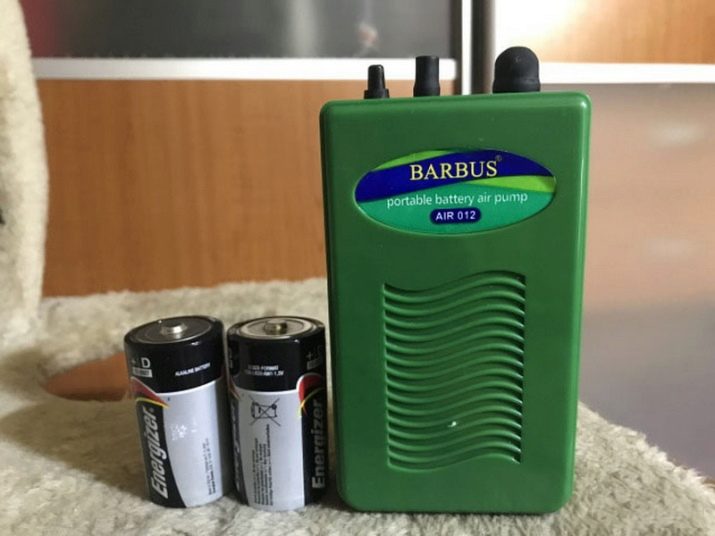
The main thing is not to forget to change the batteries in a timely manner, which in the device can be 2 or more.
In addition to stationary use, battery aerators are purchased as a fallback and are used in the event of a blackout. Experienced aquarists do not mind the soul in this device, since at any time of the day or night the unit is able to save the fish. It may seem to some that this is an unnecessary invention, but it is enough for a fish lover to see the death of aquarium pets once, as he fundamentally changes his opinion on this issue.
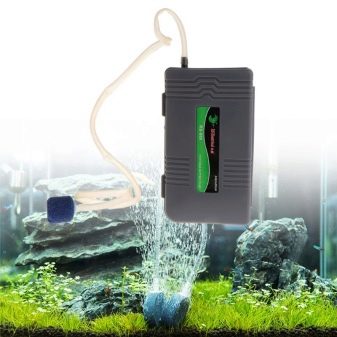
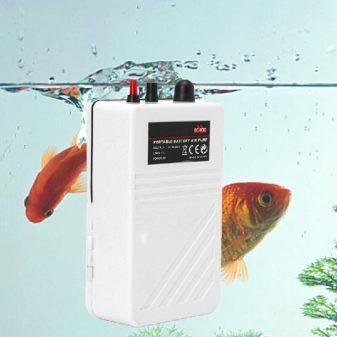
Electric
On an industrial scale, not even 2, but as many as 5 or more devices are used, according to the operation system resembling a car engine. For home aquariums, miniature variations are used. They are much cheaper in cost and occupy an insignificant place in the aquarium space than other aerator options.
Special attention should be paid when familiarizing yourself with an electric aerator. engine power, which should be about 50 watts while doing 900 rpm.
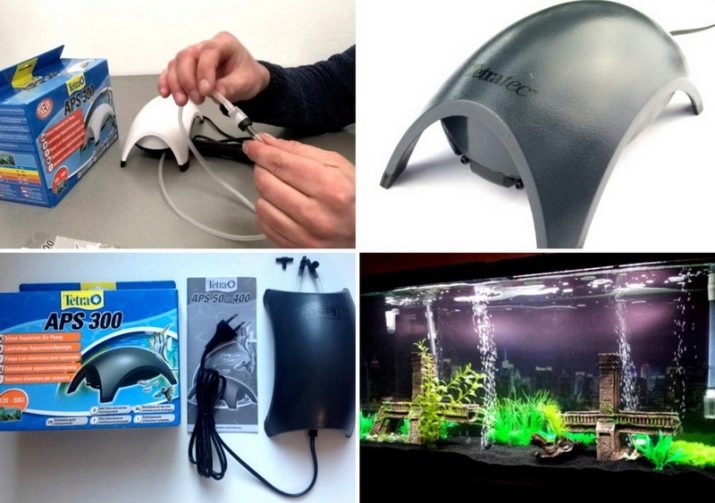
If the compressor proposed by the seller will have high performance indicators, then the reliability of the system design is significantly reduced.
How to choose?
To choose a high-quality compressor for the aquarium in which plants grow, cute and charming creatures live is not an easy task. Thanks to the exceptional equipment, the aquarium life will flourish for many years. If somewhere to save or not pay attention to any nuance, the entire habitat of the glass container will soon die.
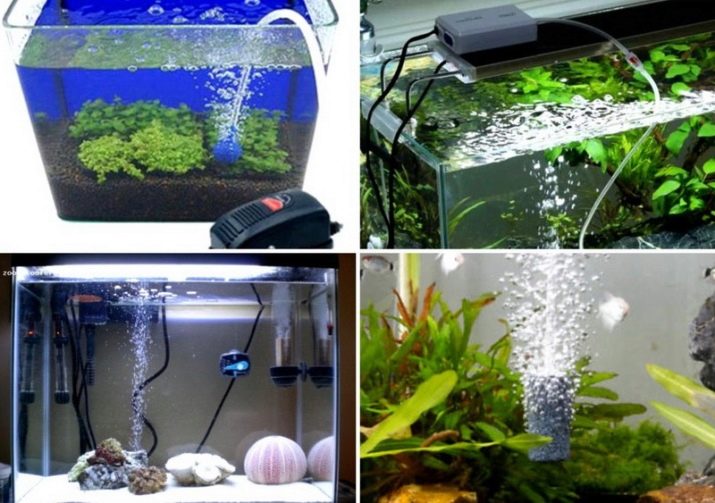
When purchasing the most suitable option for the aquarium, you need to pay attention to many important nuances.
- Design feature. Membrane variations of compressors during continuous operation do not wear out. They do not need to take long breaks or just disconnect from power for several hours. In addition, diaphragm compressors consume far less power. The only insignificant drawback is their power - it is not as large as that of powerful piston varieties of aerators, which are used in aquariums with a volume of at least 150 liters.
- Power connection. Most compressors operate by connecting them to the mains. The main thing is to follow the step-by-step instructions during installation and supplement it with a check valve. The absence of this element can lead to unpleasant consequences. In the event of sudden blackouts, water from the aquarium may begin to spill over the compressor to the floor. Needless to say, the living world inside the glass structure will remain without oxygen. On the other hand, you can consider options for compressors running on batteries or on battery power. They can be used as an additional or stationary device, which is very convenient in areas with constant power outages. The only drawbacks of self-powered units are their low power, since each individual battery is designed for only 12 volts, and in the acquisition of the power sources themselves.
- Compressor power. This indicator is measured in terms of liters per hour, which makes it clear the amount of air supplied to the aquarium in 1 unit of time. The minimum aerator power can be calculated immediately at the time of purchase. The main thing is to know the calculation formula, for example, 0.5 liters per hour (indicator on the compressor box) is multiplied by the volume of aquarium water in liters.
- Depth. This indicator plays an important role in the installation of the compressor. The heavier the water column is, the more power will be spent on the operation of the aerator.
- Voltage regulation. We are talking about the possibility of independent changes in the voltage of the supplied air, presented in the size and quantity of bubbles. Unfortunately, this function is not present in all types of compressors, but with the right approach, even a novice aquarist will be able to independently regulate the oxygen supply by compressing the oxygen tube.
- Air filter. Widespread popularity today began to use compressors 2 in 1, having an air filter that serves as an air purifier from dust. Initially, oxygen is processed through a filter, and then fed to the aquarium.
- Compressor volume. Any aerators are equipped with motors, which to one degree or another make humming sounds during operation. Moreover, each individual species differs from its counterparts in the level of noise. It may seem to an inexperienced person that the sound accompaniment depends on the size of the aerator, but in fact even mini-models are capable of making a loud, unnerving sound. If the aquarium is located in a bedroom, it is best to consider a model of a quiet compressor. Of course, such a unit will have to spend a large amount, but at night the sound of the compressor will not affect a person’s sound sleep.
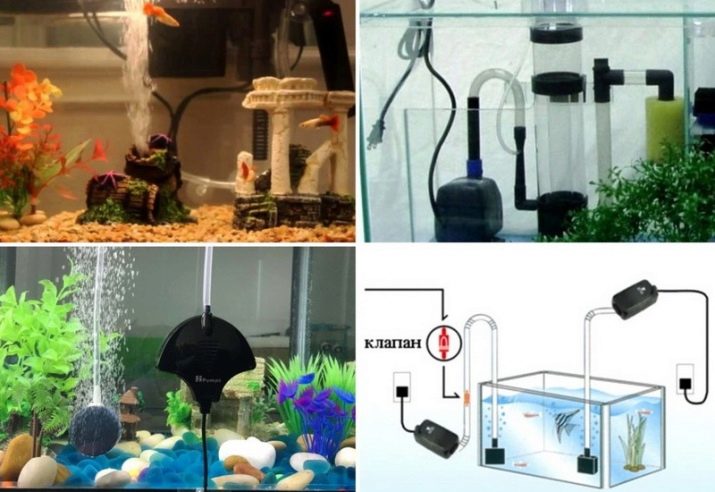
How to install?
It may seem that installing a compressor for a home aquarium takes a lot of time and effort, but in fact there are no problems with placing the device inside a glass structure. Even in the absence of experience, a beginner aquarist may be able to independently install and connect the device, spending only an hour.
In general, the installation of the compressor consists of two stages of operation.
- The spray gun is fixed first. It is best to immerse it at the very bottom of the aquarium, although it can be placed on the wall at the bottom of the glass structure, but so as not to damage the soil for plants and the composition of live algae. Then connect the oxygen hoses to the atomizer and bring them out through a special connector in the cover of the structure. It is very important not to forget to install a check valve.
- The second stage is about installing the device. It should be located outside the tank, but the water level in the aquarium should be slightly lower than the device itself. If this is not possible, you will need to install a special check valve, which will prevent the accumulation of fluid inside the compressor system.
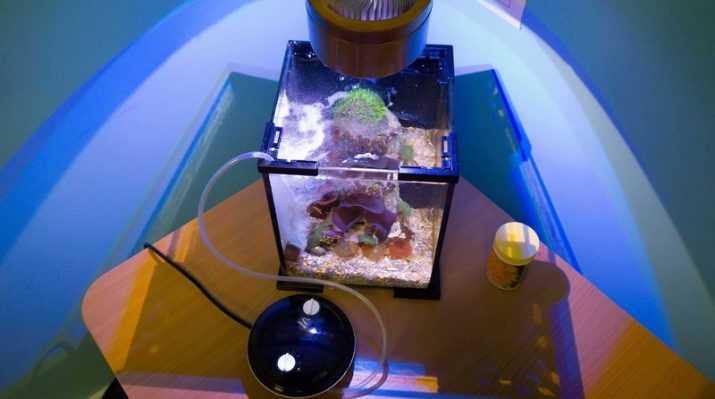
Special attention should be paid proper connection of the compressor to the mains. In most cases, a tee with several outlets for plugs is purchased for the aquarium, since not only the compressor, but also other devices will have to be connected.

It is undesirable for the tee to be located very close to the aquarium in order to exclude the possible ingress of water.
Terms of Use
Aerators, better known as compressors, have no complicated layout in their design. After installation, a high-quality unit works like a clock, but nevertheless, when using it, you should pay attention to some subtleties and nuances.
- Pay attention to the cooling of the aerator. Of course, if the device is installed correctly and used according to the instructions, there can be no overheating in the system. And he would not need any time to rest. If suddenly the temperature of the unit begins to exceed the norm, the device must be returned for repair. Experienced aquarists can try to fix the compressor on their own, as the possible causes of the malfunction may be the lack of a check valve or water entering the system.
- It is necessary to carefully read the issue of round-the-clock operation of the aerator. Most aquarists turn off the power at night. But at night, algae and other plants growing in the aquarium cease to produce oxygen, but continue to emit carbon dioxide. If, nevertheless, there is a need to disconnect the compressor from the power supply, it is best to do this during the day when oxygen from the disconnected aerator naturally compensates the plants. These facts allow you to save the life of the aquarium world. For a long time, fish without air will not be able to live.
- Duration of non-stop operation of the unit. Compressors are usually turned off for a short period of time, for example, when the aquarium needs to be cleaned. But in general, the device can work without rest for a long time, especially if the device is of high quality and is in excellent condition. To increase the reliability of the aerator, a check valve should be installed.
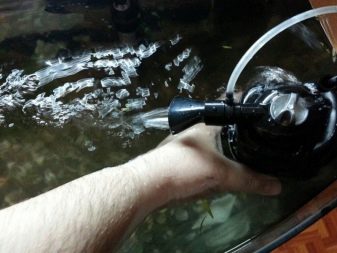
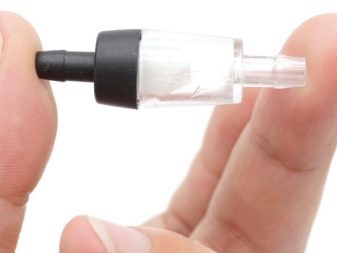
In fact, there is no consensus among aquarists how much you can turn off the aerator, but, on the other hand, if there are no problems, you can not disconnect the device from the network.
From the above information, it becomes clear that even the rules for operating compressors do not have serious requirements. A quality aerator should work like a clock. Often switching off and on a perfectly functioning device is not recommended, most importantly, with the planned disconnection from the network, do not leave living organisms in the aquarium world for long without oxygen.
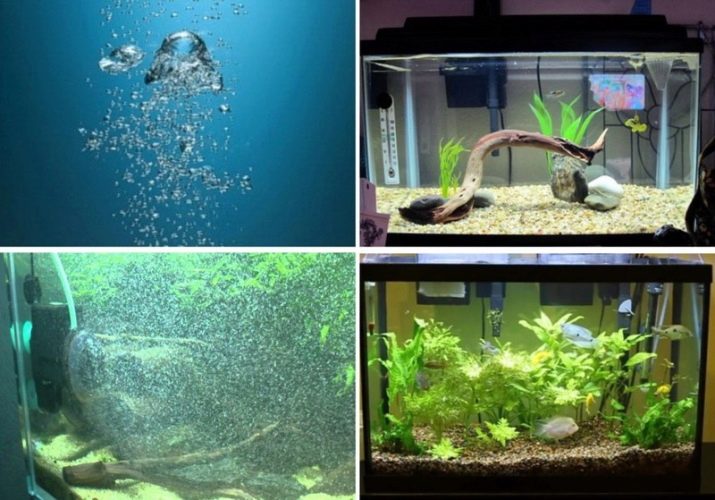
About why the aquarium needs a compressor, see the next video.
